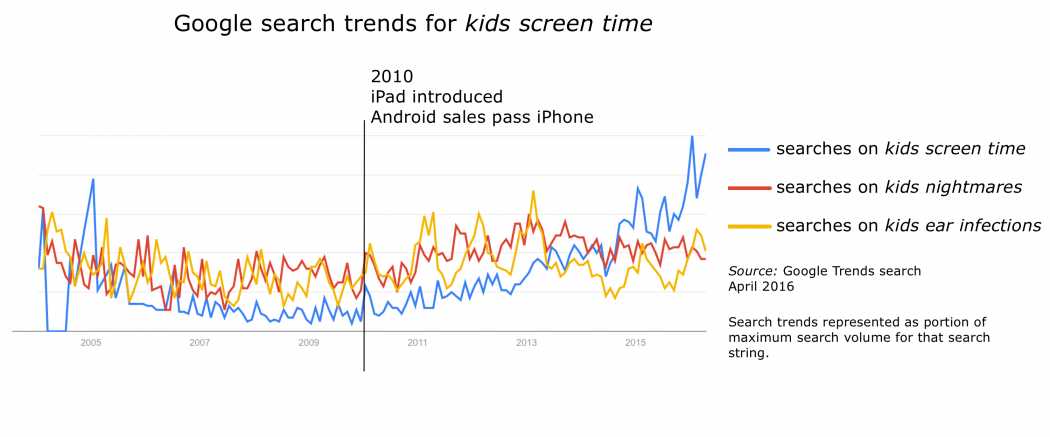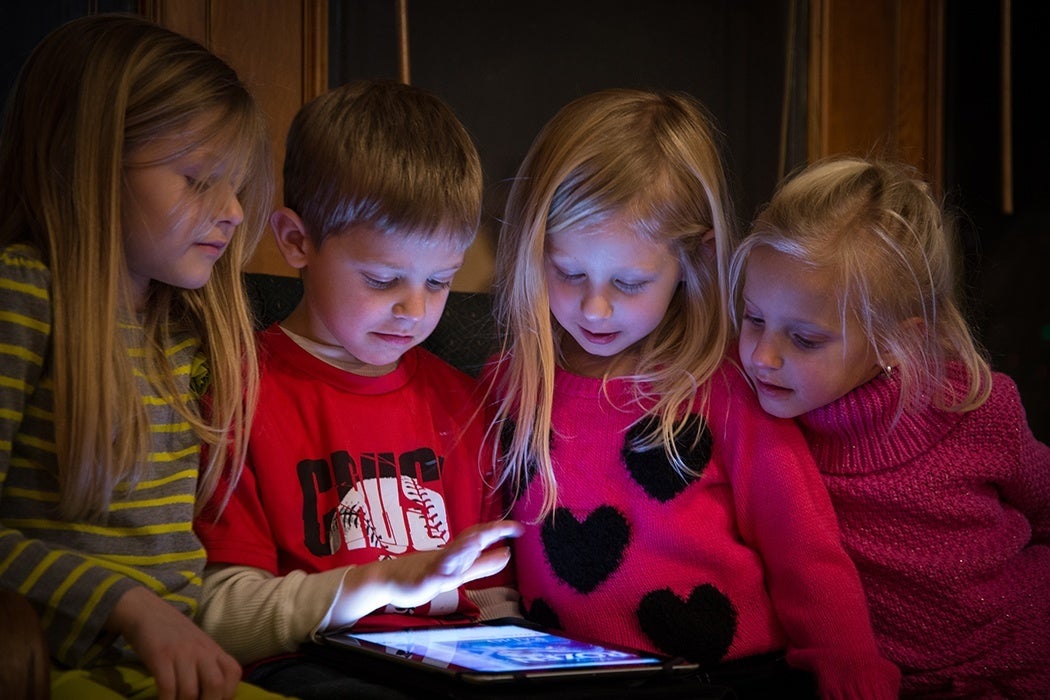Our idealized versions of both childhood and motherhood have a new enemy: screen time.
Parents are warned that screen time is making kids fat, damaging family relationships and may even cause brain damage. Handing your kid an iPhone may not be quite as bad as handing them a cigarette or a dose of heroin, but from the level of media coverage—not to mention the glares it may draw from fellow parents—it often feels just as frowned-upon. The new poster child for bad parenting is the parent texting their way through dinner, while the kids do the same.
But let’s get real. When we fret about excess screen time as bad parenting, what we’re really talking about is bad mothering. After all, mothers still do more than three times as much routine child care as fathers do, and almost four times as much solo care, according to a 2011 study by Lyn Craig and Killian Mullan. When we worry that parents are shirking their duties by relying on an electronic babysitter, we’re really worrying that mothers are putting their own needs alongside, or even ahead of, their kids’ needs.
It’s a worry that rears its head any time someone comes up with a technology that makes mothers’ lives easier. As mothers, we’re supposed to embrace—or at least nobly suffer through—all the challenges that parenting throws at us. We’re supposed to accept having little people at our heels while we’re trying to buy the groceries, make dinner, or go to the bathroom. We’re supposed to accept the exhaustion that comes from working a full day at the office and a second shift at home before falling into bed for an inevitably interrupted sleep. We’re supposed to accept the isolation that comes from raising children in a world that regards a crying child as a crime against restaurant patrons or airplane travellers.
The mother who hands her child a smartphone is taking the easy way out of these challenges. But since so much of parenting consists of situations in which there is no easy way out, I’m deeply grateful when somebody offers me a cheat. I love being able to hand my kid an iPhone in a restaurant so we can go out for dinner on a night when nobody feels like cooking or cleaning up. I love knowing I can get a few quiet minutes for a business call — if I let the kids watch Netflix. I love being able to have an actual conversation with a friend while my kids enjoy their Minecraft time. Steve Jobs may have banned iPhones and iPads for his own kids, but I bet he would have rethought that position if he’d actually spent every day at home with them, instead of off running Apple.
I’m not going to suggest that intense tech use among young children is without its perils. Quite apart from the possibility that my children will be unable to function in the absence of an Internet connection (a problem I have myself), I am pretty tired of being pestered for devices.
But the dramatic claims about how screens damage kids are regularly refuted. My own research on how families manage technology, which draws on survey data from more than 10,000 North America parents, has shown that kids with more tech access actually get into less trouble with technology.
Our screen time fixation isn’t about kids at all. It’s about mothers. What’s really going on is an age-old problem: we don’t like innovations that make mothers’ lives easier.
Want more stories like this? Sign up for our weekly newsletter.
Just look at the prevailing attitude to another innovation that gave mothers more autonomy: baby formula. We know that there are significant health benefits to breastfeeding, but that doesn’t begin to explain the horrified looks you attract when bottle-feeding in public. (The glares I got for bottle feeding my baby were good preparation for the glares I now get when I hand over my iPad.) As Cindy Sterns writes, “by deciding to formula feed, the woman exposes herself to the charge that she is a ‘poor mother’ who places her own needs, preferences or convenience over her baby’s welfare. By contrast, the ‘good mother’ is deemed to be one who prioritizes her child’s needs even (or perhaps especially) where this entails personal inconvenience or distress.”
When we shame women for adopting labor or sanity-saving innovations, we don’t limit ourselves to guilting them over the damage they’re doing to their kids: we also guilt them for what they’re doing to the earth itself. If disposable diapers emerged as one of the great symbols of environmental waste, that’s in keeping with the idea that women should be prepared to sacrifice themselves not only to the demands of motherhood, but of the greater good. The focus on “what you can do at home to save the earth,” Stacy Alaimo notes, “shifts the focus from patriarchal capitalism to the home and places the blame and responsibility, not on corporate polluters, scandalous lack of government controls, or waste-oriented capitalism but ultimately on homemakers, who had better use cloth diapers and keep those pots fully covered.”
Even before the advent of the contemporary environmental movement, saving women time took a backseat to saving men time, or to saving the earth. “Investment in labor-saving equipment for the farm took priority, partly because men made these decisions on their own,” writes Joy Parr, in her fascinating study of the differences between Canadian and American adoption of washing machines.
But whether we’re guilting mothers for the damage they’re doing to their kids, or guilting them for the damage they’re doing to the earth, our anxiety about making mothers’ work easier is rooted in our profound reservations about liberating women from the demands of the home. As Judith McGaw observes, “While woman’s place as service worker for her husband and children remained unquestioned, the industrialization of the home inevitably remained partial and superficial. New household appliances entered the home, but, unlike industrial machines, they did not achieve economies by operating continuously or on a large scale,” while “the larger farms promoted by mechanization and specialization increased rural women’s traditional isolation.” McGaw points out that didn’t have be the case: “Successful alternative societies, such as the Shakers and Oneida communitarians, generally created institutions for collective, evolutionary spatial design and shared a commitment to eliminating conventional families and to overcoming women’s isolation from other women.”
That isolation isn’t incidental to our feelings about mother-assisting technologies: it’s foundational. One of the core insights of feminist history and philosophy is the role of the “public” and “private” spheres in reinforcing the subordination of women. The public world of work and politics was historically the world of men; the private world of the home and family was the world of women. As Amy Allen writes, “the exclusion of women from the bourgeois public sphere is not accidental or contingent but rather constitutive of that space.” The history of feminism can be read as the history of contesting that divide: of women transgressing into the public world by voting, working outside the home or even running for political office.
Portable electronics are the latest technological innovation to support that transgression. With a smartphone or tablet tucked into her purse or diaper bag, the mother of young kids no longer has to fear going to a public event, restaurant, or café: if Junior gets restive, Mom can hand over the device. Armed with that digital security blanket, the world of un-disruptable public spaces once again becomes accessible to mothers and children, presenting the horrifying possibility that a table of business dudes may actually have to endure the nearby presence of small humans during their power lunch.

It’s no coincidence that our alarm about kids’ screen time has escalated so dramatically since screens became portable, moving screen use from a private in-home choice into a public spectacle that’s subject to external criticism and debate. Google searches on “kids screen time” have steadily escalated in the past 6 years, while searches on other similarly popular kid-related topics have stayed constant. Six years ago is when the iPad came out, and when Android sales overtook iPhone sales — the two developments that ushered in the widespread practice of handing portable devices to little kids.
When we glare at mothers who allow their kids to have screen time in public, we aren’t really shaming them for their technology use. We’re shaming them for something much worse. We are shaming them for asserting their own needs. We’re shaming them for actually venturing out, with their children, into the public realm. We’re shaming them for daring to be seen.







